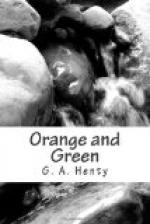The Irish did not oppose the crossing, and as soon as his forces were across the stream, William ranged them in order. They consisted of a large body of Danish, Dutch, and Enniskillen horse, and a considerable force of infantry. As soon as all were in order the king, though still suffering from the wound he had received the day before, drew his sword and put himself at the head of his troops.
The Irish right wing, which consisted chiefly of infantry, moved forward to meet them, but perceiving the numerous cavalry, led by the king himself, preparing to take them in flank, they halted, faced about and marched slowly to the little hill of Donore. Having gained this point, they again faced round and charged down upon the British, who had followed them closely.
At this moment the Irish cavalry, who had moved rapidly from the centre to the support of the right, charged down upon the Danish and Dutch horse led by the king, and no sooner had they come in contact than the Danes and Dutch turned and rode off, with the Irish cavalry in pursuit. The king rode towards the Enniskilleners. Colonel Wolseley told his men that it was the king, and asked if they wished to follow him. They replied with a shout, and the king, placing himself at the head, rode towards the Irish infantry; but as they advanced they were met by a well-directed volley, and, being much more fond of plundering and slaughtering than of close fighting, they turned horse and rode away.
Again and again the king rallied his infantry and brought them back to the fight, but the Irish infantry stood their ground with great steadiness, until Hamilton, their general, was wounded and taken in a charge of cavalry. After this, they fell back from Donore upon Duleek in good order, the enemy not wanting to molest them, and the rest of the Irish infantry followed their example.
No more singular battle than that of the Boyne was ever fought. In the morning, at break of day, part of James’s army, with most of his artillery, were in march for the pass of Slane, and actually on their retreat. The left wing, composed chiefly of French infantry, supposed to be the best troops in the army, never fired a shot. The centre and right, composed entirely of Irish, most of whom had never before been in battle, were alone engaged. With the exception of his Dutch guards, all William’s foreign troops had been repeatedly broken; his cavalry had been driven off the field by the Irish horse, while no division of the Irish was broken or suffered a decided defeat, until the infantry from the hill of Donore were compelled to retreat, which they did in perfect order.
Throughout the day, the Irish cavalry showed a vast superiority to those of the British, and even broke and destroyed regiments of infantry; and when the whole army fell back they closed up the rear, and effectually prevented any attempt at pursuit. Thus, the battle of the Boyne was fought rather to cover a retreat than defend a position. The loss on either side was estimated at about five hundred, and General Hamilton was the only prisoner taken by the British.




